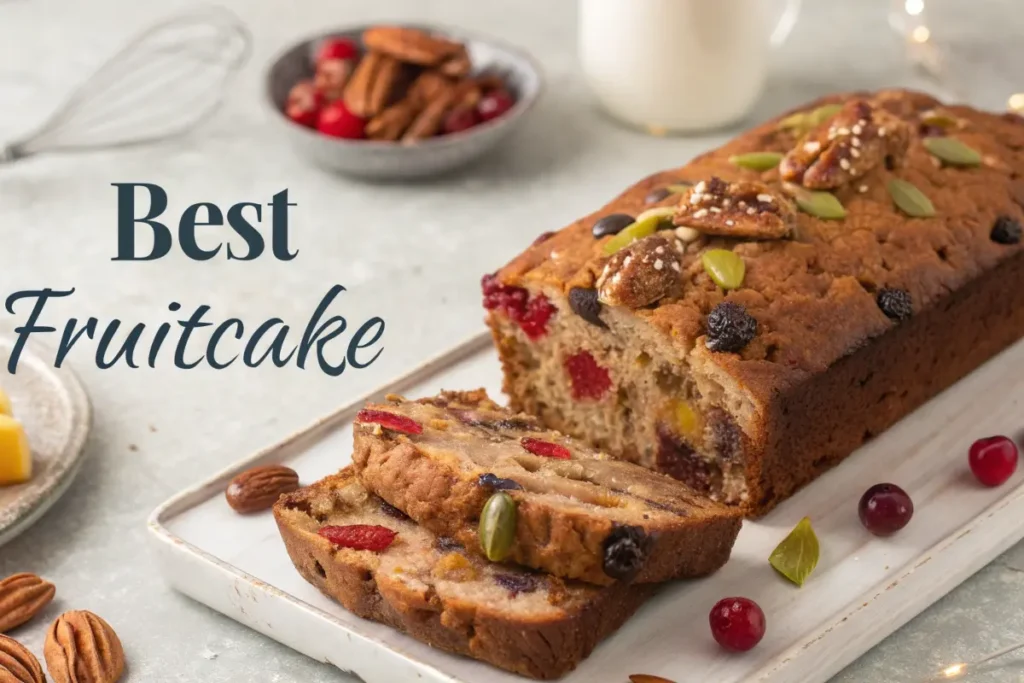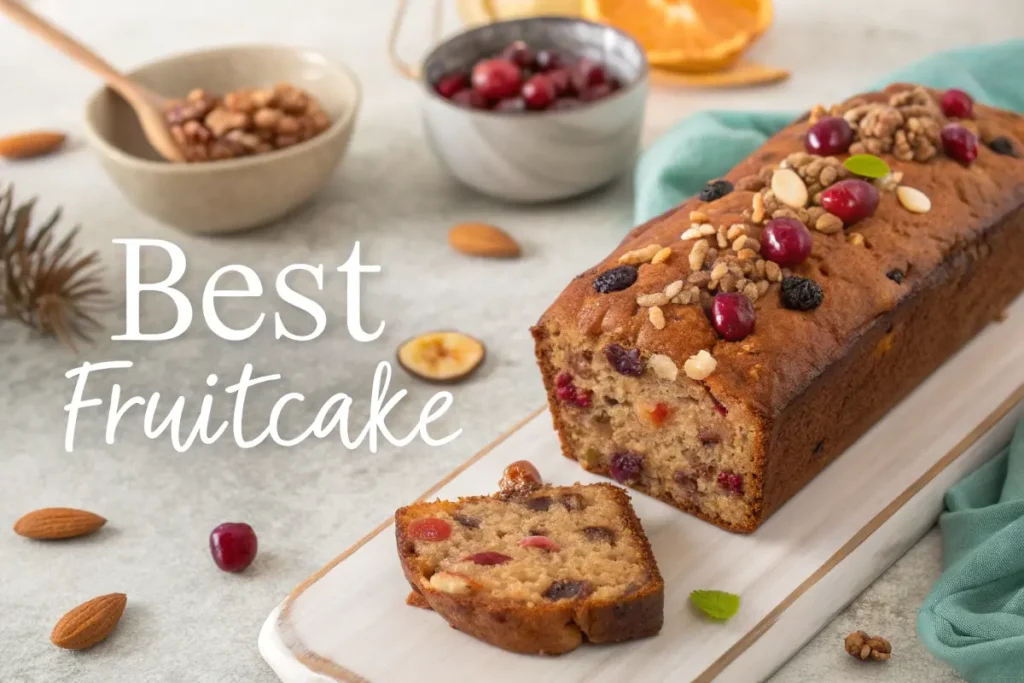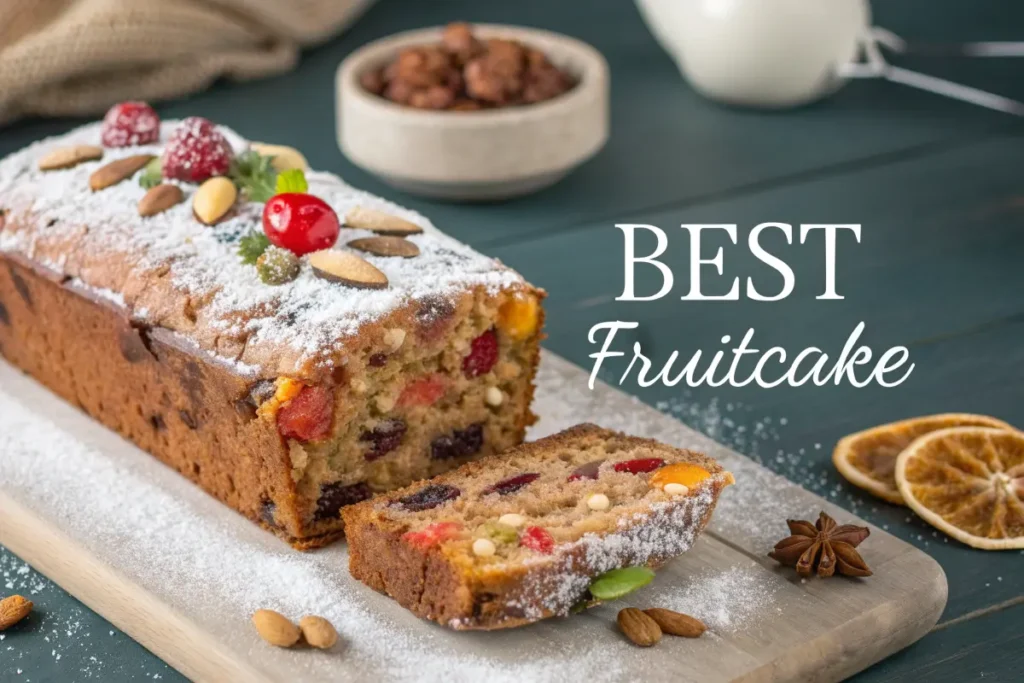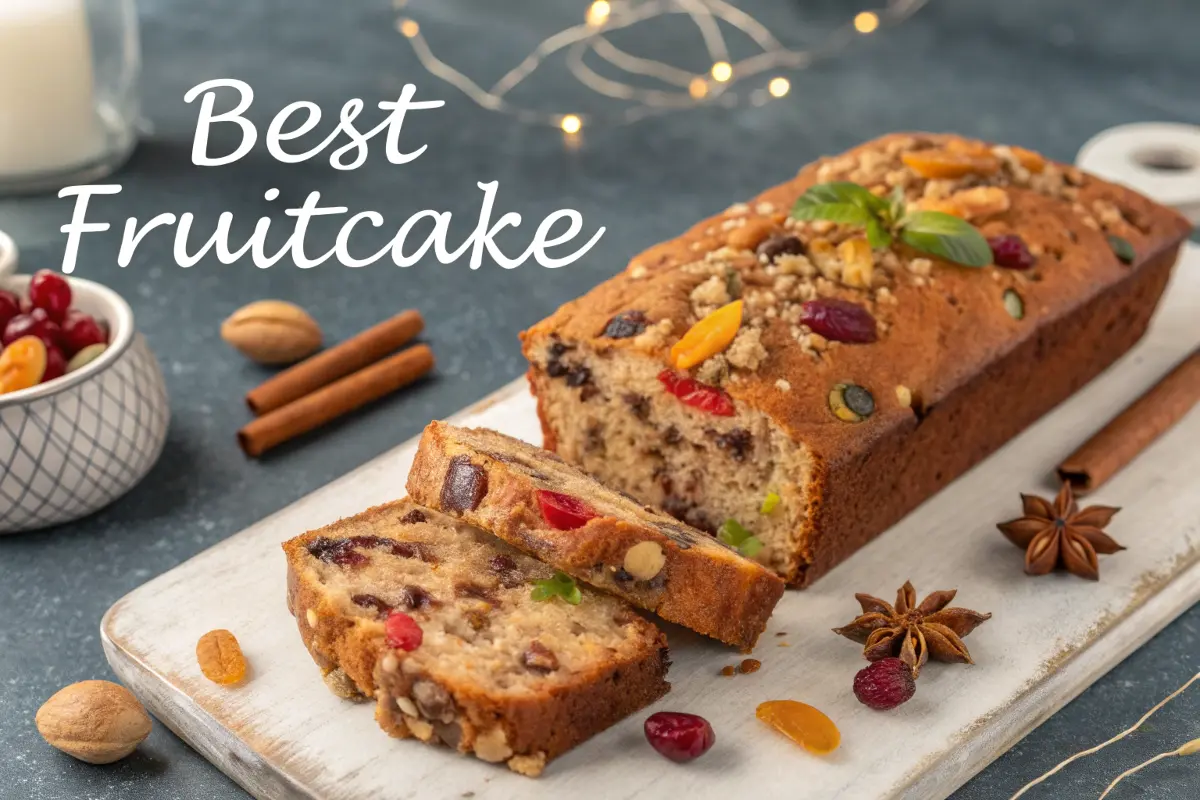1. The Rich History of Fruitcake
Best Fruitcake is more than just a holiday dessert—it’s a rich, dense bread packed with dried fruits and nuts, and it carries a fascinating legacy through the ages. Originating in ancient Rome as a simple blend of barley mash, nuts, and pomegranate seeds, this treat has evolved significantly. By the Middle Ages, fruitcake had become a festive staple, symbolizing celebration and often gracing tables during holidays and special occasions. Its enduring popularity lies in both its unique flavor and its cultural significance.
Modern-day fruitcakes continue to reflect their rich heritage. Variations exist globally, from the moist British Christmas cake to the rum-infused versions popular in the Caribbean. This timeless dessert has earned its place as a festive staple.
Why Fruitcake Deserves a Comeback
Fruitcake, a dessert often misunderstood and even ridiculed, is now regaining its well-earned reputation. As the tides of culinary trends shift, the humble fruitcake stands poised for a revival. Let’s explore why this classic dessert deserves a place in modern celebrations.
1. Exceptional Longevity
Fruitcake’s incredible shelf life is one of its standout features. Properly prepared fruitcakes, enriched with spirits and high sugar content, can last for months without losing their quality. This longevity is not only convenient but also rooted in tradition:
- High Sugar Content: The abundant sugar acts as a natural preservative, ensuring the cake remains moist and flavorful.
- Alcohol Infusion: Brandy, rum, or whiskey is often used to soak fruitcakes, enhancing both flavor and preservation. Regular brushing with spirits keeps the cake fresh and aromatic.
- Perfect for Festive Gifting: Its durability makes it an ideal gift that can be enjoyed long after the holidays.
A properly stored fruitcake can even improve with time, as the flavors meld together, offering a richer, more complex taste.
2. Nutritional Benefits
Unlike many other desserts, fruitcake offers a surprising array of health benefits, thanks to its wholesome ingredients. Packed with dried fruits and nuts, this dessert provides:
- Fiber: Ingredients like raisins, figs, and dates add dietary fiber that supports digestion.
- Vitamins and Minerals: Dried fruits are rich in vitamins A, C, and potassium, while nuts contribute magnesium and calcium.
- Healthy Fats: Almonds, walnuts, and other nuts provide heart-friendly fats that boost overall well-being.
By indulging in a slice of fruitcake, you’re not just treating your taste buds but also nourishing your body. For those with dietary restrictions, modern recipes even include gluten-free and sugar-free versions, catering to a wide audience.
3. Versatility in Serving
Fruitcake’s versatility is another reason for its resurgence. This dessert can be enjoyed in numerous ways to suit various preferences and occasions:
- Plain or Glazed: A simple slice of fruitcake can be a delightful treat, or you can add a touch of glaze for extra sweetness.
- Paired with Beverages: Enjoy it with coffee, tea, or a glass of wine for a perfect pairing.
- As a Base for Desserts: Use fruitcake in trifles, puddings, or even as a crumble topping.
- Decorated for Special Events: Add icing, marzipan, or dried fruit garnishes to make it a showstopper for weddings or holidays.
Whether you prefer a classic presentation or a creative twist, fruitcake’s adaptability ensures it fits into any gathering or meal.

4. A Dessert with History and Tradition
Fruitcake’s roots trace back to ancient Rome, where it was made with pomegranate seeds, pine nuts, and barley mash. Over centuries, it evolved into the beloved dessert we recognize today. Here are a few reasons its historical significance adds to its appeal:
- A Symbol of Celebration: Fruitcake has long been associated with festive occasions, from weddings to Christmas.
- Global Appeal: Many cultures have their unique versions of fruitcake, showcasing its universal charm.
- A Taste of Nostalgia: For many, fruitcake evokes cherished memories of family gatherings and holiday traditions.
Rediscovering fruitcake is like taking a delicious journey through history, connecting the past with the present.
5. Modern Innovations in Fruitcake
Contemporary bakers and chefs have breathed new life into fruitcake, crafting versions that cater to today’s tastes. These innovations make it more appealing to a younger audience:
- Reduced Sweetness: Modern recipes often use less sugar, focusing on natural sweetness from fruits.
- Flavor Enhancements: Additions like dark chocolate, exotic spices, or citrus zest elevate the traditional flavor profile.
- Health-Conscious Variants: Vegan, gluten-free, and keto-friendly fruitcakes are gaining popularity, making this dessert more inclusive.
- Artisanal Touches: Handmade fruitcakes with premium ingredients offer a gourmet experience.
These creative updates ensure that fruitcake stays relevant and enjoyable for all generations.
Why Fruitcake Is More Than Just a Dessert
It is not merely a sweet treat; it represents resilience, tradition, and a shared sense of celebration. Its ability to adapt to changing tastes while preserving its essence makes it a timeless classic.
So, why not embrace the fruitcake renaissance? With its long shelf life, nutritional value, and endless serving options, this dessert is more than deserving of its comeback.
Key Takeaways:
- Fruitcake’s longevity, thanks to sugar and spirits, makes it an excellent long-lasting dessert.
- Dried fruits and nuts provide a range of health benefits, including fiber, vitamins, and healthy fats.
- Its versatility ensures it can be enjoyed in various forms, from plain slices to elaborate creations.
- Modern innovations cater to contemporary tastes, ensuring fruitcake’s relevance.
- The rich history of fruitcake adds cultural and nostalgic value to every bite.
Ready to rekindle your love for fruitcake? Try experimenting with recipes or find an artisanal version to enjoy its timeless charm.s Tuscan treat blends honey, nuts, and spices for a delightfully rich experience.
Crafting the Perfect Fruitcake at Home
Making a stellar fruitcake requires patience, quality ingredients, and a few insider tips. Here’s how to achieve perfection:
Ingredients
- Dried fruits (raisins, cherries, apricots)
- Nuts (almonds, pecans, walnuts)
- All-purpose flour
- Butter
- Brown sugar
- Eggs
- Baking powder and spices (cinnamon, nutmeg, cloves)
- Brandy or rum
Steps
1. Prepare the Fruits
Soak dried fruits in liquor overnight to enhance flavor and moisture. This step is crucial for creating a rich, tender cake that bursts with fruity notes.
2. Mix the Batter
Cream butter and sugar until fluffy, then gradually add eggs, mixing well after each addition. Sift together the flour, baking powder, and spices, and incorporate them into the wet ingredients. The batter should be smooth yet thick enough to hold the fruits.
3. Combine
Gently fold in the soaked fruits and nuts. Ensure even distribution to avoid clumps and ensure every bite is flavorful.
4. Bake
Line a loaf pan with parchment paper and pour in the batter. Bake at 325°F (165°C) for 1-2 hours, depending on the pan size. Check for doneness by inserting a toothpick—it should come out clean.
5. Age the Cake
Once cooled, brush the cake generously with liquor, wrap it tightly in foil, and store in a cool place for at least a week. This aging process allows flavors to meld, resulting in a moist, deeply flavored cake.
Pro Tips
- Opt for high-quality dried fruits and nuts for the best taste.
- Don’t skip the aging process; it’s the secret to an exceptional fruitcake.
- Customize with your favorite spices or a splash of vanilla extract for a unique twist.

Pairing Fruitcake With Beverages
Enhance your fruitcake experience with the right beverage pairing. Here are some top choices:
Tea
- A warm cup of Earl Grey or spiced chai complements the cake’s aromatic spices.
- Green tea provides a lighter, refreshing balance to the rich dessert.
Coffee
- A bold espresso cuts through the cake’s sweetness, creating a harmonious contrast.
- Latte lovers can enjoy the creaminess that mellows out strong flavors.
Other Pairing Ideas
- Hot chocolate for a cozy winter treat.
- Sparkling water with a splash of citrus for a non-alcoholic option.
These pairings transform fruitcake from a simple dessert into a gourmet indulgence that fits any occasion.
Where to Find the Best Fruitcake
Finding it is a quest worth undertaking. Here are some sources to explore:
Bakeries
- Specialty bakeries often craft artisanal fruitcakes with premium ingredients and traditional recipes.
- Local bakeries may offer seasonal variations or custom orders for special occasions.
Online Retailers
- Renowned brands ship fruitcakes globally, offering convenience and variety.
- Look for customer reviews and detailed descriptions to choose the perfect cake.
Local Markets
- Farmers’ markets frequently feature homemade versions for an authentic touch.
- Chat with vendors to learn about their baking methods and ingredient sourcing.
Gourmet Stores
- High-end stores stock fruitcakes made by renowned chefs or luxury brands.
- These cakes often come beautifully packaged, making them ideal for gifting.
Pro Tip
For those who prefer to buy rather than bake, thoroughly research reviews and ask for recommendations. A well-chosen fruitcake can be a showstopper at gatherings or a thoughtful gift for loved ones.ese options ensure a high-quality treat.
FAQs
What famous fruitcake is made by monks?
The famous fruitcake made by monks is the Monastery Fruitcake, produced by Trappist monks in certain monasteries, known for its rich, dense texture and traditional ingredients.
Which is better, dark or light fruitcake?
The choice between dark and light fruitcake depends on preference. Dark fruitcakes have a richer, spicier flavor due to molasses, while light fruitcakes are milder and often contain fewer spices.
What is the original fruitcake?
The original fruitcake dates back to ancient Rome, where a mixture of honey, nuts, and dried fruit was combined into a cake, serving as an energy-rich food for soldiers.
Did fruitcake originate in Egypt?
While fruitcakes were enjoyed in ancient Egypt, the modern fruitcake, with its candied fruit and alcohol-soaked base, evolved in medieval Europe, particularly in Italy and England.
Why do fruitcakes last so long?
Fruitcakes last long because of their high sugar and alcohol content, which act as preservatives, preventing spoilage and allowing them to age well when stored properly in a cool, dry place.
Can you eat a 20-year-old fruitcake?
Yes, a 20-year-old fruitcake can be eaten if stored properly, as the alcohol and sugar preserve it. However, its flavor may change, and it might be drier or firmer.
What is the difference between fruitcake and Stollen?
The main difference between fruitcake and Stollen lies in the texture. Stollen, a German cake, has a softer, bread-like consistency, while fruitcake is denser and packed with candied fruits and nuts.
Does fruitcake get better with age? Yes, fruitcake often improves with age. The flavors meld together as it matures, especially if stored in a cool, dark place and periodically soaked with alcohol to maintain moisture.Conclusion: Rediscover the Joy of Fruitcake

Conclusion
Fruitcake is a timeless treat with a rich history that spans cultures and centuries. Whether you prefer the dark, robust flavors of a classic recipe or the lighter, more delicate notes of a modern version, there’s a fruitcake for every taste. From its origins in ancient Rome to its contemporary status as a holiday favorite, this beloved dessert continues to captivate both seasoned connoisseurs and curious newcomers alike. With so many variations available, it’s easy to find a fruitcake that suits your preferences perfectly.
So why not give fruitcake a chance this season? Dive into its fascinating history, savor the rich and complex flavors, and perhaps even start your own fruitcake tradition. Don’t let this holiday classic pass you by—experience the magic that makes fruitcake a global favorite. If you’re ready to try or perfect your fruitcake recipe, check out some of our top recommendations and tips. Let this year be the one where you discover the joy of fruitcake!

